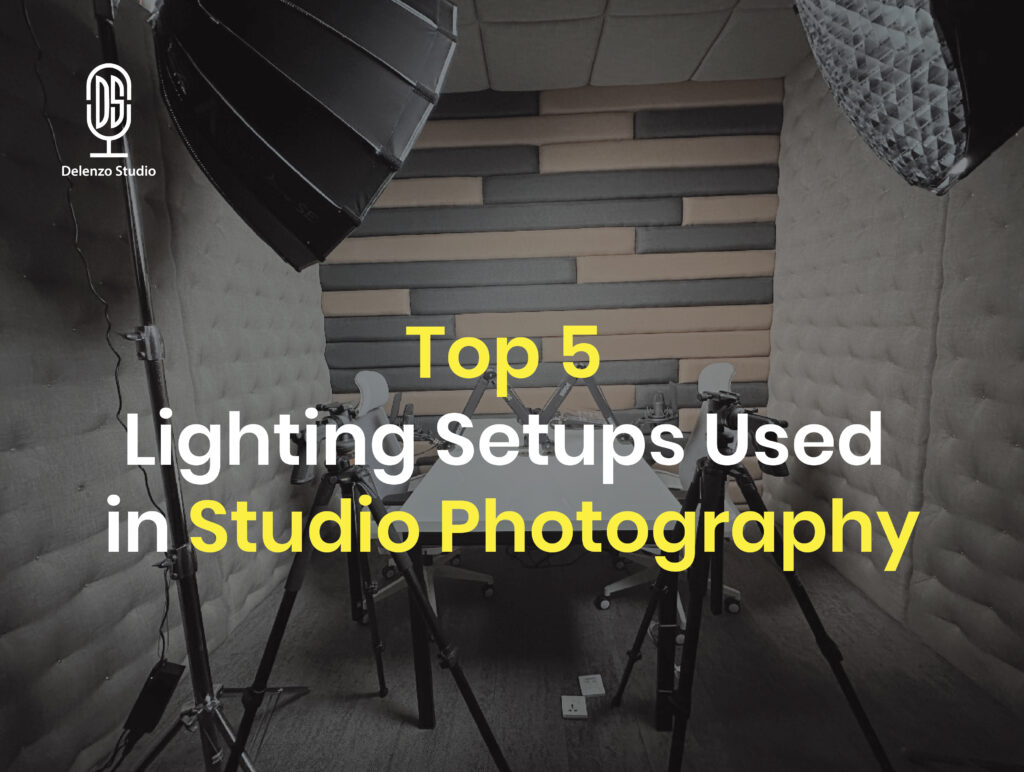
Have you ever wondered what makes studio photos pop? It’s all about lighting setup! In studio photography, light isn’t just illumination; it’s a game-changer. It can completely transform an image, making your subject shine and setting the perfect mood.
Proper studio lighting is key whether snapping portraits, still life, or getting super creative. Different ways of using light can make your photos feel a certain way, set the mood, and show off amazing details.
So, are you ready to light up your photography? This article will explore the top 5 lighting setup options for studio photography. We’ll break down how each works and share practical lighting tips to help you create truly stunning photographs. Let’s get lit!
Why Lighting Setup Matters in Studio Photography
Regarding studio lighting, how you light your subject defines the shot’s outcome. Proper lighting setups can accentuate textures, bring out the best in facial features, and create depth. Moreover, even the most expensive camera and lenses may fall short without the correct lighting. Lighting helps establish the atmosphere, whether for dramatic shadows, a soft glow, or sharp contrasts.
Top 5 Studio Lighting Setups Explained
Let’s explore five popular lighting setups to enhance your studio photography. Each setup offers its unique flair and is suitable for different shots. By understanding how these light systems work, you can easily apply them to your projects.
Rembrandt Lighting
One of the most iconic and versatile setups is Rembrandt lighting. This light system is renowned for creating a dramatic yet flattering effect, making it a favorite for portrait photographers.
In this setup, the key light is placed at a 45-degree angle to the subject and above the subject’s eye level. Consequently, a characteristic triangle of light on the subject’s cheek, opposite the light source, results. The Rembrandt lighting setup works beautifully for both men and women, adding depth and interest to facial features.
Butterfly Lighting (Paramount Lighting)
Butterfly lighting, or Paramount lighting, is ideal for creating glamorous, high-fashion portraits. In this setup, you place the key light directly above and in front of the subject, pointing downwards at a 45-degree angle. This setup highlights the cheekbones and creates a soft shadow under the nose, forming a butterfly-shaped shadow.
This setup works exceptionally well with models, giving them a smooth, youthful appearance with enhanced skin texture. It also provides a sleek, refined look for beauty shots and close-ups.
Loop Lighting
Loop lighting is one of studio photography’s simplest and most widely used lighting settings. In this configuration, the key light is positioned at a 30 to 45-degree angle to the subject, slightly above their eye level.
Moreover, the small loop-shaped shadow beneath the subject’s nose sets loop lighting apart. It’s a flattering and easy-to-set-up technique, perfect for portrait photography. The light doesn’t create harsh shadows but offers some contrast, ensuring the face looks dimensional and well-lit.
Split Lighting
Split lighting is one of the most dramatic lighting arrangements. In this setup, the key light is placed at a 90-degree angle to the subject’s face, illuminating one side while casting the other entirely in shadow.
As a result, this effect creates a striking contrast and works wonders for moody, intense shots. Split lighting is frequently used in black-and-white photography, emphasizing textures and details in the shadows. Although it’s great for bringing out strong features in subjects, it’s typically best for creating a bold, dramatic look rather than softer portraits.
Clamshell Lighting
Clamshell lighting is a go-to for soft, flattering, and well-rounded lighting. This setup involves using two light sources: one above the subject and another below them.
The upper light is usually the key light, while the lower light, usually a fill light, softens any shadows. This combination creates an even, beautiful glow, perfect for beauty shots, product photography, or fashion shoots where smooth skin and balanced lighting are essential.
Bonus Tips for Better Studio Lighting
Beyond understanding these fundamental lighting setups, a few additional lighting tips can take your studio photography to the next level.
- First, use reflectors to help bounce light onto your subject, filling in shadows without additional light sources. They are an excellent tool for softening the light and controlling the shadows.
- Next, try softboxes and umbrellas to diffuse the light, creating a softer, more even distribution. It is beneficial when working with clamshell lighting or any setup that requires soft light.
- Also, controlling the background by adjusting the background lighting is just as important as lighting the subject. Use backdrops that complement your lighting settings and add texture or color to the overall shot.
- Then, experiment with light angles. Changing the angle of the light can significantly affect the mood and depth of your images. Try experimenting with different light positions to discover new and interesting effects.
- Finally, Use Gels for Color Effects. Adding colored gels to your lighting arrangement can transform the atmosphere of your shot. Plus, these are great for creating mood lighting or adding creative color effects.
Why Delenzo Studio is Perfect for Professional Lighting
At Delenzo Studio, we understand the importance of a professional lighting setup in studio photography. Therefore, our studio is designed with versatile lighting options, allowing photographers to experiment with various lighting systems. From soft lighting for portraits to bold, dramatic contrasts, Delenzo Studio in Lahore, Gulberg, provides all the equipment and space you need to create stunning, professional shots. Whether you’re a beginner or a professional, our studio ensures that your lighting arrangements will be flawless, helping you capture the perfect shot every time.
Final Thoughts
In conclusion, lighting setup is the backbone of successful studio photography. Mastering the top lighting arrangements, such as Rembrandt, butterfly, loop, split, and clamshell lighting, can transform any scene into a work of art. So, experiment with different setups, and don’t be afraid to tweak your lights to suit the mood or style you’re aiming for. Happy shooting!
FAQs
Yes, you can experiment with various lighting setups in a single shoot to see how they affect the mood and overall look of the photograph. It’s a great way to discover the best lighting for your subject.
Studio lighting can offer more control, but natural light often provides a soft and flattering look. Each has pros and cons, depending on the desired effect and your goals.
No, you don’t necessarily need expensive equipment. With proper knowledge of lighting tips, you can experiment with affordable tools like reflectors or softboxes to achieve professional results using basic studio lighting setups.



